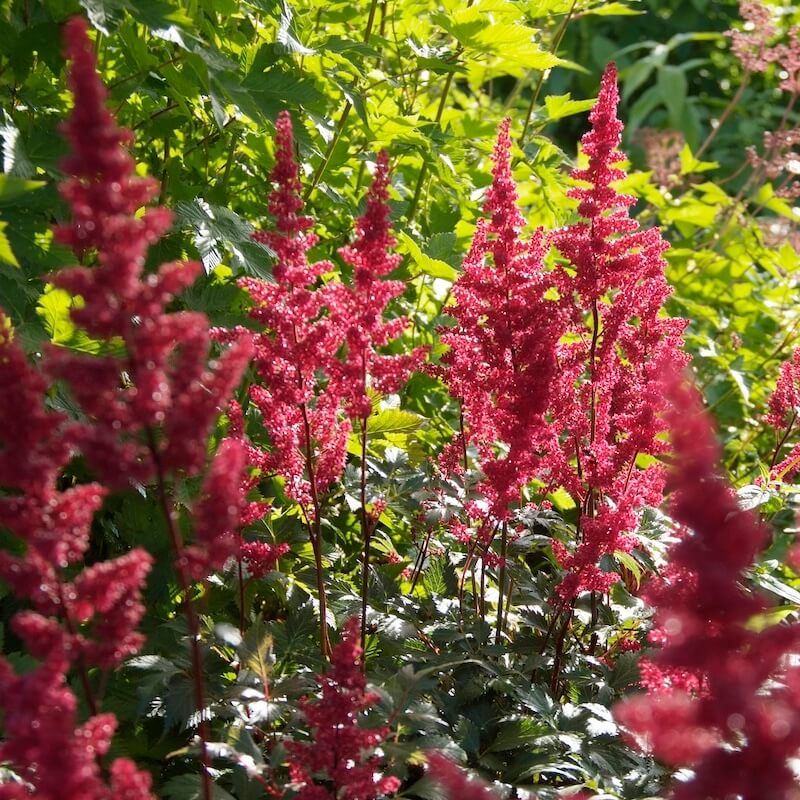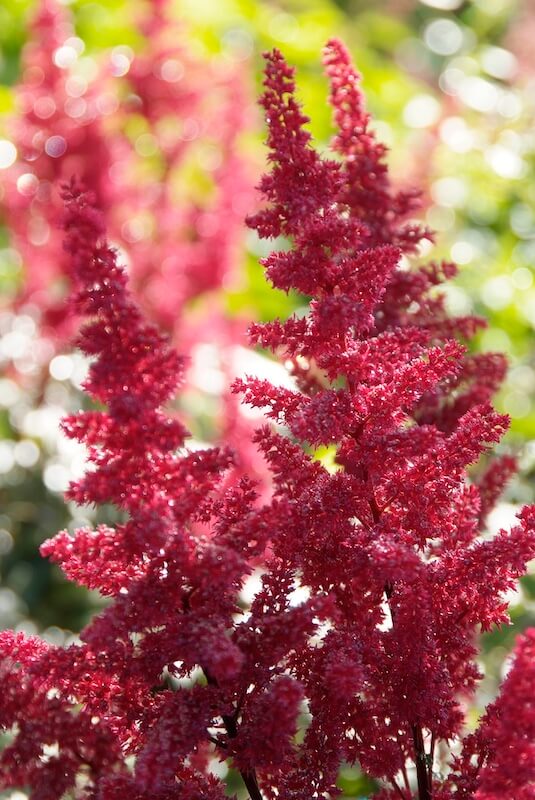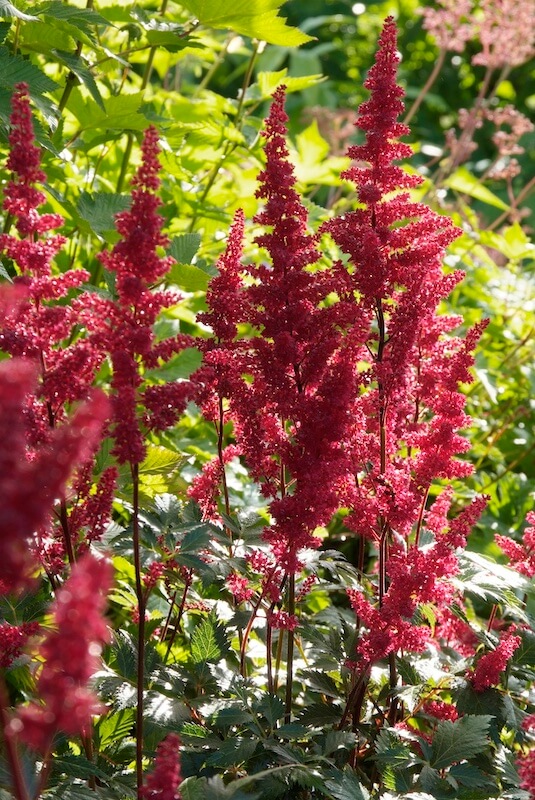Astilbe Fanal - The Crimson Star of Shady Gardens
Astilbe arendsii Fanal, Astilbe x arendsii Fanal

Position
- Prefers partial shade but can tolerate full sun if the soil remains moist
- Ideal for borders, woodland gardens, and pond edges where the soil doesn’t dry out
- Combines wonderfully with other shade- or moisture-loving perennials
Hardiness
- Hardy to approximately –20°C (–4°F)
- Well suited to most UK gardens, including colder regions
Soil
- Thrives in rich, moist, but well-drained soil
- Appreciates soil improvement with compost, well-rotted manure, or leaf mould for extra fertility and moisture retention
- Dislikes dry or sandy soils unless regularly watered and improved to retain moisture
- Tolerates acid, neutral, or alkaline soils
- Very adaptable across a range of UK garden soils, provided moisture is available
- Grab a soil test kit and ensure the perfect conditions for growth
Height
- Typically grows to 60–75 cm (2–2.5 feet) after 5–10 years
- Forms a neat clump of upright stems and dense, fine-textured foliage
Seasons of Interest
- Foliage: Attractive, finely divided, deep green leaves from spring to autumn
- Autumn Colour/Variegation: Foliage may turn bronze or reddish before dying down; no variegation is present
- Flowering: Dense, deep red plumes appear from June to July, standing out boldly above the foliage
- Flowers are attractive to pollinators and also work as cut or dried flowers
Additional Notes
- Mulch in spring with compost or leaf mould to retain moisture and enrich the soil
- Water regularly during dry periods, especially newly planted specimens or those in sunnier spots
- Deadhead spent flowers or leave the faded plumes for the autumn and winter structure
- Divide congested clumps every three to four years in spring or autumn to maintain vigour
- Pest and disease resistant; low maintenance once established
- Suitable for containers provided consistent moisture is maintained
Why Astilbe Fanal Belongs in Your Shade Garden
If you’re searching for a show-stopping plant that thrives in shade and delivers bold colour, Astilbe Fanal could be your perfect match. With its deep crimson-red plumes, lush green foliage, and reliable habit, this herbaceous perennial adds drama and texture to both garden borders and shaded corners.
What makes Astilbe Fanal such a garden favourite?
Astilbe Fanal is part of the x arendsii hybrid group, known for their robust habit, long-lasting flowers, and shade tolerance. What sets fanal apart is its vibrant, deep red plumes and dark green leaves. These red flowers appear on strong, dark stems, offering a stunning contrast against its feathery foliage.
It grows to around 60 cm tall and spreads into a tidy clump, making it ideal for mixed borders, woodland gardens, or waterside plantings. The flowers bloom in early summer, starting as tiny, clustered flowers in plume-like spikes that gradually open into a rich display. These fluffy plumes not only brighten shaded areas but also last well as a cut flower.
If you’re drawn to plants that are both decorative and easy to maintain, astilbe fanal ticks both boxes.
How should I grow Astilbe Fanal in my garden?
Astilbe Fanal is one of the best choices for shaded areas, but it’s not fussy as long as the soil stays reliably moist. It thrives in part shade or full shade, but can tolerate full sun if the soil remains cool and damp. Avoid planting it in hot sun or spots that become scorched or dry out in summer.
Choose a position in rich, organic soil with good structure. Add compost, manure or garden compost at planting time to retain soil moisture and encourage healthy growth. Mulch annually in early spring with organic matter to help conserve water and feed the plant as it grows.
A consistent supply of water is essential. Astilbes dislike drought, and even short dry spells can lead to browning or reduced flowering. For the best results, aim to keep the soil evenly moist, especially during the flowering season.

Can Astilbe Fanal grow in sun or shade?
Yes, but shade suits it best. Astilbe Fanal is most at home in shaded or dappled areas. It tolerates part shade to full shade and performs beautifully in shady areas where other perennials may struggle. In full sun, the soil must be kept consistently moist to prevent stress or leaf scorch.
Gardeners with tricky shaded borders, woodland settings or north-facing plots will find this astilbe a valuable addition. You’ll also find it works well under the cover of deciduous trees where summer light filters through, but the soil remains cool and damp.
If you must grow it in a sunnier spot, boost soil moisture with organic matter and apply mulch regularly to retain moisture.
What soil does Astilbe Fanal prefer?
Moisture-retentive soil is essential. Astilbe Fanal thrives in soil that retains water well without becoming overly wet or boggy. Clay soil can work if it drains slowly but stays evenly moist. If your soil is light or sandy, consider improving it with compost or organic matter to help it retain water longer.
The soil should also be well-drained—astilbes dislike sitting in water, especially over winter. Boggy soil can cause rot and damage the perennial crown. As a guide, think about a damp woodland floor: rich, crumbly, and evenly moist throughout the year.
You’ll also want to keep soil pH neutral to slightly acidic. Avoid planting in alkaline soil unless it has been improved.
When does Astilbe Fanal bloom?
Astilbe Fanal flowers in early summer, usually from late May to July. The exact timing depends on your region and the weather, but you can expect a reliable bloom period of several weeks. Its long flowering window makes it ideal for borders that need sustained colour.
Each flower spike is made up of hundreds of tiny flowers arranged on feathery plumes. These fluffy plumes start in deep crimson red and age gracefully over time, gradually softening in colour but holding shape well.
Deadheading is optional, but it can help the plant look tidier once the flower starts to fade. After flowering, the herbaceous perennial dies back naturally and rests until the following spring.
What are the foliage and growth habits of Astilbe Fanal?
One of Fanal’s key features is its striking foliage. The leaves are deeply divided and rich, dark green, with a slightly glossy surface that complements the red flowers. This bold foliage forms a lush mound or clump at the base, offering structure and ground cover from early spring to autumn.
New growth emerges in early spring, often with a reddish tint before maturing into dark green leaves. By late winter or early spring, you can cut back the previous year’s growth to make way for fresh new growth. This helps maintain healthy growth and keeps your planting area tidy.
The strong, dark stems that hold the flowers above the foliage provide an excellent contrast, preventing the plumes from flopping.
Is Astilbe Fanal good for cut flowers?
Absolutely. The red plumes of Astilbe Fanal are long-lasting and hold up well in floral arrangements. Their fluffy texture adds softness to bouquets, while their crimson red hue offers boldness.
To use fanal as a cut flower, harvest when about two-thirds of the flowers on the plume have opened. Place the stems in water immediately and keep the bouquet cool, out of direct sunlight. They also dry well if hung upside down in a warm, dry room.
Using astilbe in arrangements is a lovely way to bring your shady border indoors.
Can Astilbe Fanal grow near water or in woodland gardens?
Yes—these are ideal settings. Astilbe Fanal thrives in a reliably moist environment, making it ideally suited to waterside planting, damp borders, and woodland gardens. Just make sure the soil is not boggy or stagnant.
In woodland settings, the plant benefits from the natural shade of trees, decomposing leaves, and a humus-rich soil that mimics its native conditions. In these areas, the deep red plumes stand out beautifully against green foliage and dappled shade.
Plant it alongside ferns, hostas, or other shade-loving perennials to create a layered look.
How can I combine Astilbe Fanal with other plants?
Astilbe Fanal pairs well with both flowering plants and foliage-rich companions. For a soft look, try planting it with other astilbes in pink or white, or with spirea and shady bloomers like astrantias. Ornamental grasses can also add texture and motion.
For contrast, mix fanal with green foliage plants, such as hostas, brunnera, or dark-leaved heucheras. The deep red plumes create a strong focal point, so use them sparingly to highlight or punctuate wider plantings.
It also works well with spring-flowering bulbs and perennials that bloom before or after, ensuring seasonal interest throughout the year.
Where can I buy Astilbe Fanal in the UK?
If you’re ready to buy Astilbe Fanal, you’ll find it available at many reputable nurseries, garden centres, and online plant specialists. Look for healthy young plants with firm roots and rich green leaves. Avoid buying if the soil is dry or the leaves appear scorched.
You may also see it listed as Astilbe x arendsii ‘Fanal’ or simply ‘x arendsii ‘Fanal’, reflecting its hybrid heritage. As a false goatsbeard, it may be grouped with other astilbes in the herbaceous section.
Buying in the spring is best, as it gives the plant time to establish itself before the flowering season.
From Darren’s Patch
Astilbe Fanal has become a firm favourite in the shadier corners of my garden. Something is striking about the way its bold red plumes stand tall against the deep greens of hostas and ferns—it adds drama without ever feeling over the top. I often plant it near water features or under deciduous trees where the soil stays nicely damp, and it never fails to lift the whole scene. It’s also one of those plants that gives back with very little fuss—just keep it watered, mulch in spring, and it’ll reward you with weeks of rich colour. I even cut a few stems for the house; they last beautifully in a vase. If your border feels a bit flat or your shady spot lacks punch, I can honestly say this is one plant I’d never be without.
![]()
Key Points to Remember
- Astilbe Fanal is a herbaceous perennial known for its deep crimson plumes and dark green foliage
- It thrives in part shade to full shade with consistently moist soil
- Avoid dry areas—astilbes dislike drought and need evenly moist conditions
- Best planted in woodland gardens, shaded borders, or beside water
- Grows to about 60cm and forms a tidy clump
- Flowers in early summer with bold red plumes that last for weeks
- Combine with hostas, astrantias, ferns, and spirea for a lush, layered effect
- Great as a cut flower and excellent for brightening shady areas
- Improve your soil with compost or manure before planting
- Buy Astilbe Fanal in early spring from trusted UK plant suppliers
Astilbe Fanal flourishes in partial shade with moist, fertile, improved soil of any pH, and is hardy down to –20°C (–4°F). Achieving 60–75 cm (2–2.5 ft) in 5–10 years, it forms neat clumps of ferny foliage and bold, deep red plumes from June to July. With spring mulching, regular watering, and occasional division, ‘Fanal’ provides vibrant summer colour and reliable performance in UK borders, woodland plantings, and damp garden corners.
Check out the RHS article here.
If you like this one, you’ll love Astilbe Bressingham Beauty. Click here to explore it.
For more information on perennials for your garden, please click here.

Frequently Asked Questions
Q: What is Astilbe Fanal?
A: Astilbe Fanal is a compact herbaceous perennial from the Astilbe × arendsii group, prized for its striking crimson red plumes and dark green foliage. A popular choice for shaded borders and woodland gardens, it produces feathery flower spikes in early summer, rising gracefully above the foliage. Often referred to as false goat’s beard, this variety reaches approximately 60cm in height and performs best in consistently moist, well-drained soil. Astilbe Fanal adds a vibrant splash of colour to shady areas and is ideal for both mixed borders and waterside planting.
Q: Where is the best place to plant Astilbe Fanal?
A: Astilbe Fanal thrives in partial to full shade, where it is protected from the hot midday sun. Choose a location with reliably moist, humus-rich soil, such as a shaded border, dappled woodland setting or beside a pond. Astilbe dislikes drought and should not be allowed to dry out, especially during the flowering season. If growing in full sun, ensure the soil remains consistently moist. Incorporate plenty of organic matter, such as compost or well-rotted manure, to retain moisture and support healthy growth.
Q: How should I care for Astilbe Fanal?
A: To maintain healthy growth, water regularly—especially in dry weather—to keep the soil evenly moist. Apply a generous mulch of compost or organic matter in early spring to conserve moisture and feed lightly with a balanced fertiliser. Deadheading is not essential, but removing spent flower plumes can tidy the plant. In late autumn or early winter, once the perennial has died back, cut the stems to ground level. Fresh new growth will emerge in early spring. Divide clumps every few years in spring or autumn to rejuvenate older plants and improve flowering.
Q: When does Astilbe Fanal flower?
A: Astilbe Fanal typically blooms in early to midsummer, depending on growing conditions. Its fluffy, crimson-red plumes appear above dense, green foliage, offering long-lasting colour in shady parts of the garden. The flowers make excellent cut stems for floral arrangements and attract pollinators to the garden. Keeping soil consistently moist during the growing season will encourage a more vibrant and prolonged bloom period.
Q: Can Astilbe Fanal grow in full sun?
A: While Astilbe Fanal can tolerate full sun in cooler climates, it performs best in partial or complete shade. If grown in sunnier spots, it must be in reliably moist soil to prevent scorching and stress. Without adequate moisture, the foliage may become scorched, and flowering may suffer. For optimal health and display, plant it in a sheltered position with protection from harsh afternoon sun.
Q: What soil conditions does Astilbe Fanal prefer?
A: Astilbe Fanal prefers moist, well-drained soil enriched with organic matter. It will grow well in clay soil if improved with compost or leaf mould, but avoid boggy ground or sites prone to drought. Soil that remains evenly moist, particularly during the warmer months, is crucial for supporting lush foliage and a robust flower display. Mulching annually helps retain moisture and improves soil structure in heavier soils.
Q: Is Astilbe Fanal suitable for shaded areas?
A: Yes, Astilbe Fanal is ideal for shaded and woodland gardens. It thrives in partial or full shade, bringing bold colour and texture to darker corners. Its fern-like foliage and vivid red flower plumes add brightness to areas where many plants struggle to thrive. It partners well with ferns, hostas, and other moisture-loving shade perennials.
Q: Is Astilbe Fanal attractive to wildlife?
A: Astilbe Fanal is an excellent plant for attracting pollinators, particularly bees and butterflies, during its summer flowering period. While not a native species, it provides valuable nectar and pollen. It is not generally bothered by pests or diseases, making it an easy-care addition to wildlife-friendly planting schemes.
Q: Can Astilbe Fanal be grown in containers?
A: Yes, Astilbe Fanal can be grown successfully in pots, provided they are kept well-watered. Choose a large container with good drainage and fill it with moisture-retentive compost. Keep the container out of direct sunlight and feed it occasionally with a balanced liquid fertiliser. Container-grown plants may require more frequent watering, particularly during hot weather.
Q: Where can I buy Astilbe Fanal?
A: Astilbe Fanal is widely available in the UK from garden centres, specialist nurseries and online plant retailers. It is often sold in pots during the growing season or as bare-root crowns in late winter or early spring. When purchasing, look for healthy plants with strong roots and signs of fresh growth.
